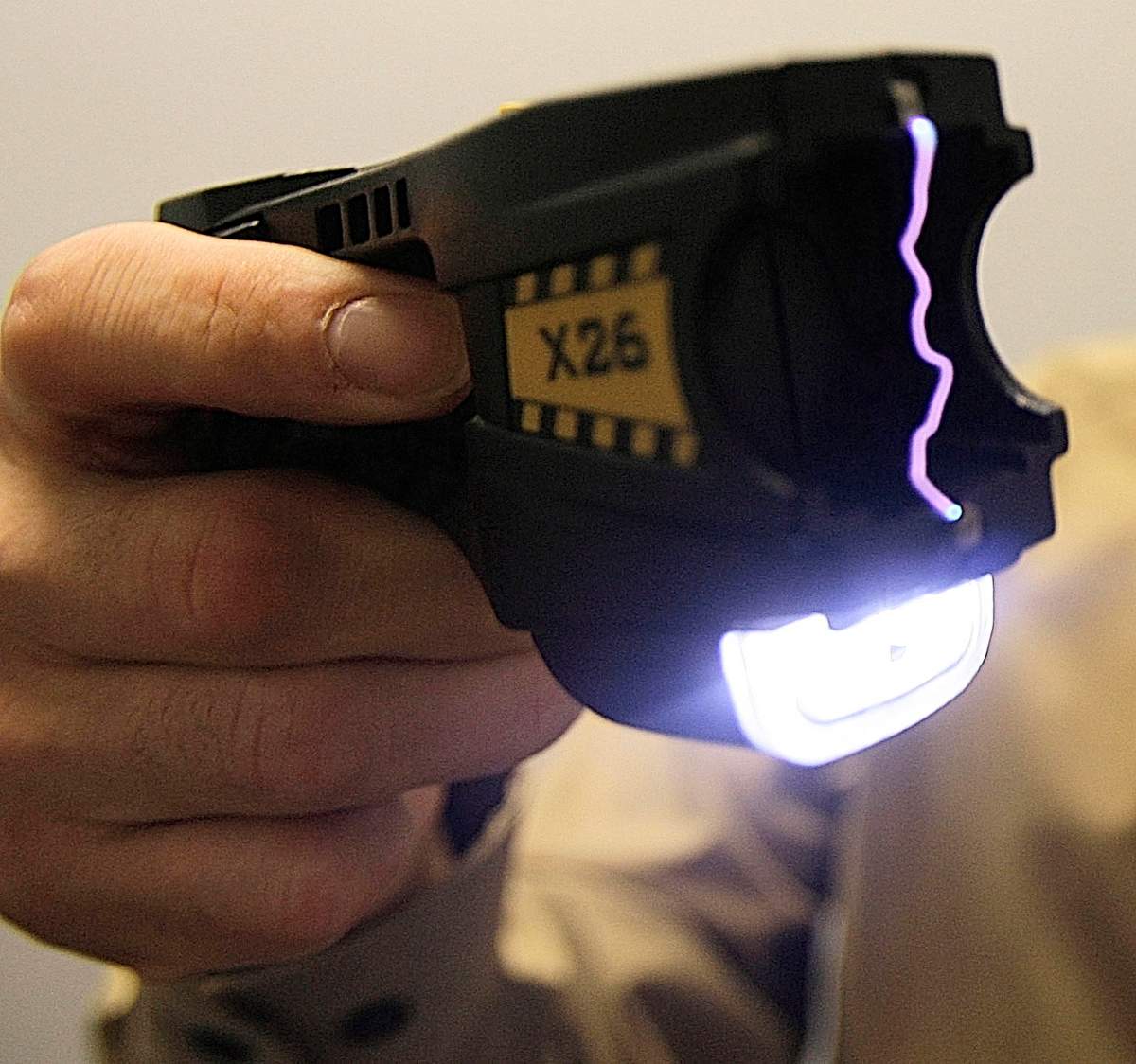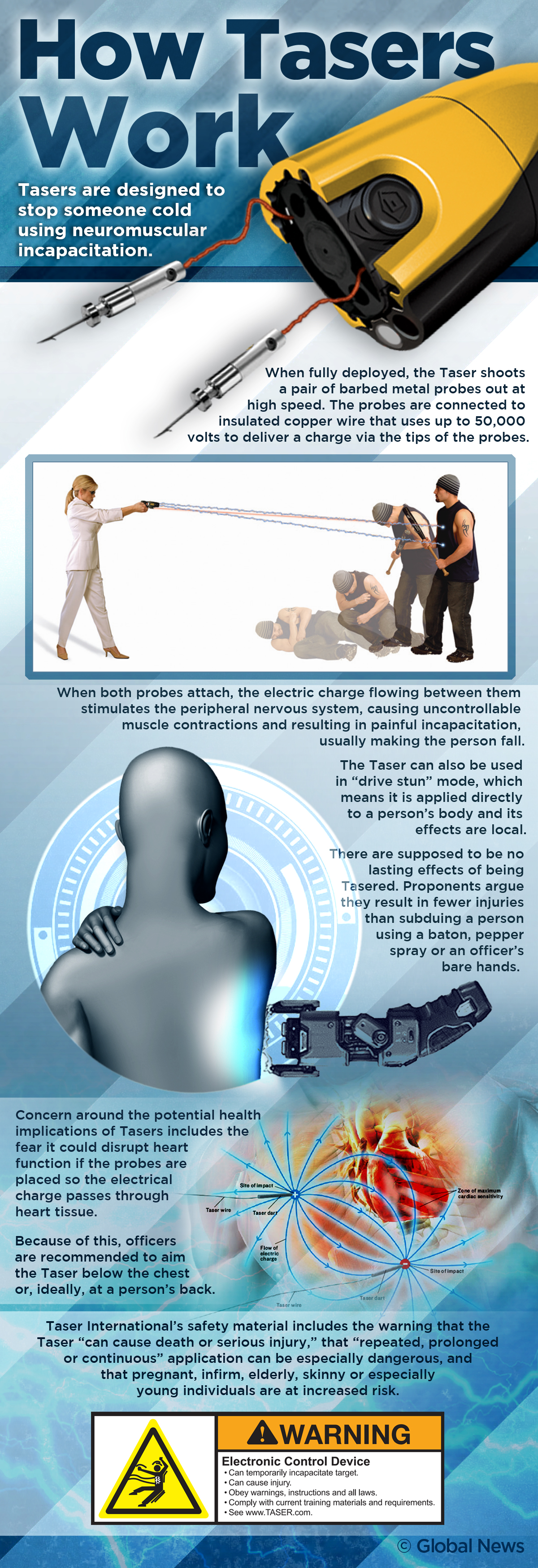WATCH ABOVE: What happens to you when you’re Tasered?

The problem with assessing the effects of Tasers on the human body is that the kind of human bodies most likely to be tasered — people who are sick, stressed, drunk, high on drugs, experiencing a psychotic episode or emotional crisis or strenuous exertion — are both most likely to experience exacerbated health complications and impossible to ethically test for them.
The short answer: If you’re perfectly healthy and sober, being Tasered will probably hurt a lot for five seconds but leave you otherwise unscathed. If you aren’t, we really don’t know.
Read the series:
How should we police Taser use?
What we found from 594 pages of Taser incident reports
Psychiatrists in blue: How do you train cops to be better social workers?
Tasers are designed for neuromuscular incapacitation: to deliver an electric charge to your body that interferes with your peripheral nervous system, creating uncontrollable muscular convulsions and rendering you temporarily unable to control your own movements.
Twin barbed darts shoot out at high speed, delivering an electric jolt through thin copper-insulated wires leashing them to the stun gun. Ideally both probes land below your chest, far enough apart to deliver a charge affecting a significant portion of your musculature.
(“Drive stun” mode, when the business end of the Taser is applied directly to the body, creates a much more local pain that generally doesn’t paralyze your whole body the way full deployment does.)
Tasers have been used in Canada for the better part of two decades, so you’d think we’d have a better handle by now on precisely what they do to the human body.
But there are still plenty of unknowns, in part because there’s no way to clinically, ethically test a Taser on vulnerable, less-healthy people who are also often a Taser’s most likely targets.

Get weekly health news
Taser International’s website claims Tasers “have saved more than 140,000 lives,” and says numerous independent studies have shown Tasers “help keep officers and suspects safe.”
Safety documentation on Taser International’s website cautions that the Taser’s use can result in “death or serious injury.”
And some individuals are particularly susceptible, including “the elderly, those with heart conditions, asthma or other pulmonary conditions, and people suffering from excited delirium, profound agitation, severe exhaustion, drug intoxication or chronic drug abuse, and/or over-exertion from physical struggle.
“In a physiologically or metabolically compromised person, any physiologic or metabolic change may cause or contribute to sudden death.”
This lack of clarity becomes clear in a 100-page paper by an “Expert Panel on the Medical and Physiological Impacts of Conducted Energy Weapons.” The 14-member panel included doctors specializing in cardiology, toxicology, epidiology and biostatistics; judges, forensic pathologists, psychiatrists and criminologists.
Their conclusions: Superficial injuries, such as bruising or fall-related mishaps or puncture wounds from the darts, are common but not medically serious. And while there have been deaths immediately after Taser use, there are frequently multiple complex factors at play that make it tough to either confirm or rule out the Taser’s role in the death, the panel found. “Available studies suggest that while fatal complications are biologically plausible, they would be extremely rare.”
There are a number of ways a Taser can potentially cause serious harm, and a number of factors that can make that harm more likely. That includes where the Taser’s barbs hit you (the closer to your heart, the more likely cardiac capture or arrhythmia become); the length of time it’s deployed, your own health (if you have heart problems or are Tasered while exerting yourself, while on drugs or drunk or in serious distress).
“The absence of evidence on neuroendocrine, respiratory, and cardiac effects of CEW electrical discharge suggests that ongoing and more comprehensive investigations are required,” the panel’s report reads.
James Brophy is a numbers guy: He likes being able to quantify evidence.
So as an expert panel participant, the McGill University cardiologist and epidemiologist found the lack of definitive conclusions frustrating. He and colleague Ben Rich sat down and tried to hash out the precise mathematical likelihood of a Taser killing you.
Brophy admits the numbers they came up with are, at best, an educated guess.
“If there were simple answers then I don’t think they would have needed to have a panel,” he said.
“We really do need to get more data. … Maybe we can’t answer those questions [about Taser-related deaths] today but we can answer them in the future if we go about collecting the research.”
That means systematically collecting and analyzing information on who gets Tasered, what their demographic and health profile is and what happens to them afterward — much more than what gets done now with even the more rigorous Taser deployment incident reports.
“I think there are circumstances where a taser could be the primary cause but its very very difficult to prove causality,” Brophy said.
“We can’t say there is zero risk with these interventions, so I would only use them if you deem that is is truly necessary.”
READ MORE: How should we police Taser use?









Comments